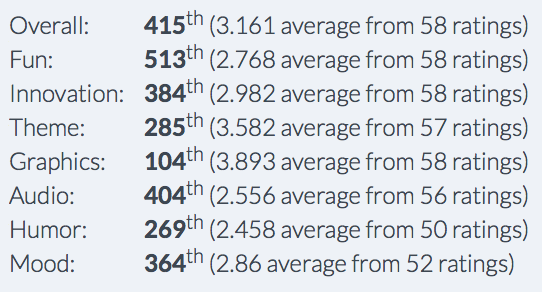Time-lapse
Last time I entered I produced a time-lapse of the development. I find these pretty interesting so I’ve done the same again.
I’ve tried to lengthen the video this time around by lowering the frames-per-second. A screenshot was captured every 30 seconds during development and there are 4 frames to each second of video. So each second of video represents 2 minutes of work.
Results
The purpose of Ludum Dare, for me at least, is to brainstorm some ideas and kickstart some creativity. And to that end, its been a success. The game I produced had lots of flaws but something in the core idea has got me excited to produce a more fleshed out version – we’ll see where that goes in the coming months.
Participants in Ludum Dare are encouraged to play one another’s games and to rate them in a number of categories. In spite of some great feedback in my game’s comment section, my results weren’t particularly encouraging.
The results below are out of 2,431 games. Also worth noting is that the ratings are out of all entries regardless of whether you did the competition (1 dev, all from scratch in 48 hours) or the jam (teams, can use existing code and assets, and have 72 hours).

Whilst at first glance it seems pretty awful (even with the caveats above), I decided to compare it to my results from Ludum Dare 25.
Ludum Dare 25 (Overall): 254/1,326
Ludum Dare 39 (Overall): 415/2,431
Both of these are within the top 20% so at least that’s something.
More importantly, we can normalise the old score against the new one.
(2431/1326)*254 = 466
This means that my score from Ludum Dare 25 translates to 466th when compared against the new score with its increased number of participants. So it looks like I’ve improved by 51 places. Not too bad after all :)
The game itself, whilst having a pleasing gameplay loop, is not a good game. There’s no real challenge and it can’t hold your interest much past a few minutes. These are things that I intend to look at for my post-jam version.